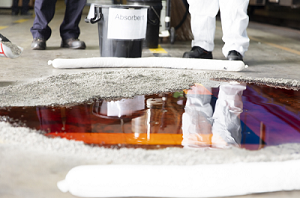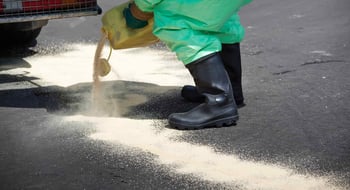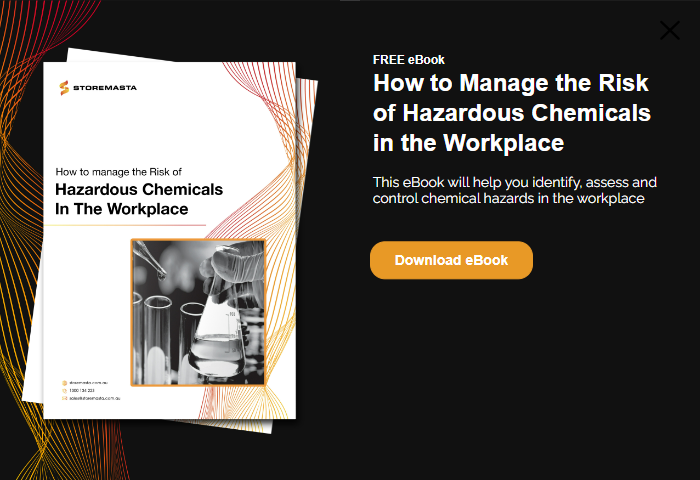For organisations that are carrying bulk quantities of Dangerous Goods, spill containment and management is one of the most significant safety considerations. Through common sense safety measures, compliant control measures and clear communication with your people, this blog will detail the ways in which you can stop bulk chemicals from spilling in your workplace.
What Are You Legal Obligations With Chemical Spills?
Every Australian organisation, regardless of the industry type or the size of your operation, has a legal obligation under Work Health and Safety (WHS) regulations to prevent the occurrence of hazardous chemical spills.
In Section 357 Containing and managing spills, the WHS Regulations states that:
A person conducting a business or undertaking at a workplace must ensure, so far as is reasonably practicable, that where there is a risk from a spill or leak of a hazardous chemical in a solid or liquid form, provision is made in each part of the workplace where the hazardous chemical is used, handled, generated or stored for a spill containment system that contains within the workplace any part of the hazardous chemical that spills or leaks, and any resulting effluent.
The risks associated with chemical spills and leaks are specific to the Dangerous Goods class of the chemical that you are storing.
Risks can include:
- Asphyxiation from hazardous vapours
- Bodily harm from corrosive or toxic chemicals
- Damage to property from corrosive substances
- Fire, flashback or explosion for flammable and combustible liquids
- Environmental damage if the spill seeps into soil, waterways or the natural environment
IMPORTANT: Under the Work Health and Safety Act, an uncontrolled chemical spill or leakage is regarded as a dangerous incident. Therefore, you must notify the regulator in your state or territory in writing following a chemical spill in the workplace.
How Can You Prevent Chemical Spills?
To prevent and contain chemical spills in the workplace, businesses must take a comprehensive approach to spill management. It’s not simply enough to place bunding under an IBC, there must be consistent practices in all areas of the organisation to ensure chemical spills are minimised.

There are many ways you can prevent chemical spills and reduce risk for your organisation and community.
Let’s look at some of the ways in which you can reduce the risk of spills in your organisation.
Maintaining Chemical Packages
Chemical packages, including IBCs and drums, should always be kept in good condition. If packages are damaged, split or leaking, they should be immediately discarded and replaced.
When your chemicals are delivered, staff receiving the goods should be responsible for checking that they arrive in good condition. IBCs and drums must be closely inspected upon arrival at your workplace for any signs of damage. They should not be accepted by your staff if any damage or leaks are noted.
Care must also be taken to wipe down any chemical residue that’s left on the chemical package after use. Even small amounts of Dangerous Goods, such as flammable liquids or toxic substances, can cause serious risks to the staff who are handling them such as asphyxiation or chemical burns. As chemicals also emit vapours which can ignite in the presence of an ignition source, containers which aren’t cleaned down after use can also present a fire or explosion hazard.
IBC and Drum Storage
Storing your chemicals in bunded Dangerous Goods containers or chemical storage containers will provide adequate spill containment if an accident does occur.

Selecting, installing and maintaining bunded chemical storage can greatly reduce the risk of chemical spills.
Important factors to consider when selecting storage include:
- Is your chemical storage container compliant? ie. Is it equipped with a liquid-tight spill containment sump that offers the required containment capacity?
- Does your bunded storage equipment suit the Dangerous Goods class and capacity of the chemicals you’re carrying? Ie. Your storage equipment will only minimise the impact of a chemical spill if it’s been designed for the type and quantity of chemical you’re carrying.
- Has your container been installed in a convenient location for transferral of liquids? i.e. You must minimise the distances between your chemical store and your handling area to reduce spill risks.
- Can you use additional equipment for safer pumping and decanting? i.e. Choosing to pump chemicals straight from an IBC will help prevent chemical spills and handling errors.
- Are you carrying out housekeeping on your storage equipment? i.e. Are any chemical leaks and spills immediately cleaned-up and disposed of in a safe manner to maintain the integrity of the spill sump?
Handling Equipment
Using equipment to transfer and handle your hazardous chemicals can reduce the risk of spills in two ways. Firstly, it assists with the movement of chemicals throughout a workplace, which causes less physical strain on the staff who are handling them. Second, the handling equipment should be equipped with bunding and control measures to reduce the likelihood of a spill.
There are many options to assist staff with the transferral of chemicals through a workplace. These include mobile waste management dollies, chemical drum dollies and bunded drum trollies. If staff are decanting hazardous chemicals, the use of detachable drum decanting equipment and IBC dispensing trays can increase efficiency and safety during the decanting process.
When you are using equipment, such as forklifts, to manoeuvre IBCs, make sure that the handling equipment is operating as it should. A forklift that jerks or jumps can cause an IBC to be dropped, which can result in a chemical spill. Ensure that your handling equipment has been maintained and serviced, and that the operator has been provided with adequate training to safely carry out their job.
Training Staff
When working with any class of Dangerous Goods, a high standard of staff training is crucial. Some key points to cover in your training sessions may include:
- Teaching staff how to correctly handle, transfer and decant chemicals
- Making sure that staff know how to identify a spill risk
- Educating staff about how to use chemical containers and storage equipment
- Providing detailed information about the specific risks associated with chemical spills
- Training staff to use the applicable PPE in the correct way
- Providing the appropriate supervision for staff who are handling Dangerous Goods
Organisations should create a set of operating procedures for staff who handle hazardous chemicals. The operating procedures should include specific details on chemical handling and loading procedures, installation, use, maintenance and monitoring of control measures, and the identification and removal of hazards.
These procedures should be fully understood and implemented by staff, with refresher courses regularly offered so the training remains relevant and effective.
Spill Response
If a bulk chemical spill did occur in your workplace, would your staff know how to respond? An important part of spill prevention is developing a chemical spill response plan in the event of an accident.

Preparing for a chemical spill includes providing the right spill kits, clean-up procedures, emergency evacuation plans and staff training.
Your plan will include procedures for containing and cleaning-up the chemical spill, including how to use the clean-up kits and dispose of the chemical waste and resulting effluent. Chemical spill kits vary, but usually contain PPE, neutralising agents, materials to soak up the chemicals, as well as tools and containers for chemical waste. The instructions within the safety kit should already have been communicated to staff, so they are ready to respond to the chemical spill as soon as it occurs.
Your spill response plan should form part of your emergency plan, and include details on emergency evacuations, notifying emergency services and isolating the chemical spill so it doesn’t spread further throughout the worksite.
IMPORTANT: To create a spill response plan for your business, you should start with an onsite risk assessment. This will allow you to identify and assess the Dangerous Goods that you have onsite, as well as developing and maintaining controls to assist with the management of chemical spills.
Reducing The Likelihood Of Bulk Chemical Spills
If you’re storing hazardous liquids in large drums or IBCs, we hope this blog has helped you answer the question, ‘How do you stop bulk chemicals from spilling?’ By preparing for the worst-case scenario, you’ll be covering all aspects of spill prevention — in all areas of your organisation. From developing procedures and training staff to choosing bunded chemical storage and spill kits, you can minimise the likelihood and impact of hazardous chemical spills.
To find out more about reducing chemical hazards, you can grab a free copy of our eBook. How To Manage The Risk Of Hazardous Chemicals In The Workplace will help you identify and manage risks, including chemical spills, in your own organisation. Get your copy today by simply clicking on the image below.
Joining the team as a Dangerous Goods Storage Consultant, Melissa Hampton became Storemasta's Marketing Manager in late 2021. With extensive knowledge and experience in chemical compliance, Melissa is responsible for leading the Marketing team and helping shape their marketing strategy. In her spare time, you can find Melissa hiking, swimming and enjoying the great outdoors in beautiful north-west Tasmania.
